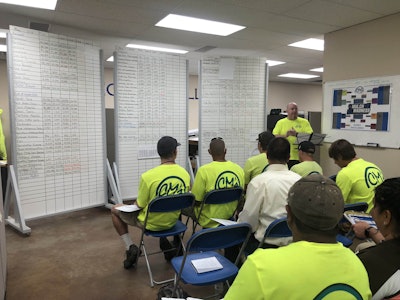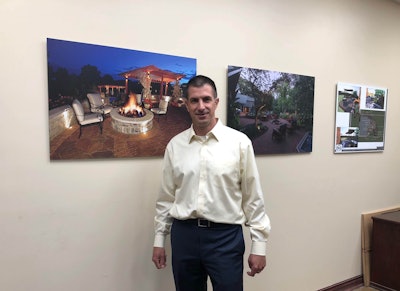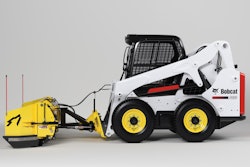 CM’s A Cut Above employees hold their weekly huddle to discuss company financials.
CM’s A Cut Above employees hold their weekly huddle to discuss company financials.Photo: Jill Odom
This is part one in a two-part series. The sequel article will publish on TLC tomorrow.
Inside a building that used to house a roller-skating rink in Omaha, Nebraska, employees of CM’s A Cut Above gathered for their weekly huddle.
Three whiteboards covered in grids listed the income, cost of goods sold and expenses of each week for the month.
The huddle serves as a company-wide meeting updating the team on their progress toward monthly goals, as well as educating the group on why the numbers have either gone up or down.
Matt McMaster, grounds maintenance division manager for the company, led the meeting as different employees read off different line items, while another wrote on the whiteboard in green if the number was higher than planned, red if it was lower than planned and black if the number was the same as planned.
As the employees reported the financials from their different divisions, they explained why revenue had either increased or decreased for certain services.
It was only the company’s fourth month conducting the whiteboard process, but the concept came from the open-book management philosophy known as The Great Game of Business.
“Our goal is to inspire,” said Chuck Monico, president of CM’s. “It’s more than opening the books; it’s more about creating a culture of owners, the mindset of an owner and for them to be invested at that level.”
Not only are the numbers tracked on the whiteboards, but each employee also has a binder to track the months along with industry comparisons. The huddle also highlights the forecast, which helps workers think ahead to see where they can help reach those goals.
Workers also took the time during the meeting to praise each other and crews for their good work. When the meeting came to a close, McMaster called out “Expect!” and the rest of the room called back “Excellence!” before they set out for the day.
CM’s makeup
Monico founded his company in 1987 but he had had an interest in landscaping and starting his own company since he was in his teens.
“I think it was pretty clear through high school and college that I wanted to work with a team of people where it felt like I could go ahead and assist them and have a positive influence on their lives in a more intimate surrounding,” he said.
While Monico enjoys landscaping, he says it’s probably not his true passion.
 Chuck Monico founded the company in 1987.
Chuck Monico founded the company in 1987.Photo: Jill Odom
“My passion is trying to provide opportunities for people to work at a company with an aspirational culture and among people with positive attitudes and to provide the best client service possible,” he said.
He credits the company’s success to the combination of those who are truly passionate about landscaping, along with those who excel on the business side of things. CM’s employs around 50 workers, with about 10-12 being seasonal labor.
Service-wise, 65 percent of the business is design/build work, while 35 percent is recurring revenue maintenance services including mowing, fertilization, irrigation, plant management, tree care and holiday lighting. Eighty percent of CM’s clients are residential, and 20 percent are commercial.
Monico says they are currently pursuing a higher percentage of recurring revenue work. He doesn’t plan for the design/build portion to shrink but to merely grow their recurring revenue side.
Will Reinhart, COO of CM’s, says they are trying to increase the density of their clients by placing flyers in neighborhoods they currently work in and are upselling their tree services when out conducting plant maintenance.
Due to a recent high demand in decks and pergolas in the area, CM’s has also recently hired a carpenter, so they can take advantage of that market.
The business’s range is about an hour away from the shop, and Reinhart says they hope to open up an office or facility elsewhere to increase their geographic reach, but this is still a long way off.
Like the majority of landscaping companies, an overwhelming amount of CM’s business is from customer referrals. While the company has a 92 percent retention rate, it is still evaluating how it can reach more customers.
“We’re going to go through this marketing plan consultation process because we do realize that we are leaving a chunk of the market out there that we should be touching or at least have an opportunity to work with, so we need to improve that,” Monico said.
Part of the process is considering a rebranding, as the company’s name is simply Monico’s initials combined with another company called A Cut Above, which was acquired in 2011.
“We’ve been counseled that we should not change it significantly because it seems to have a very positive vibe, and people know the name,” he said.
Another area that CM’s plans to work on with the marketing company is its use of social media and how actively they should use it. On the company’s website, the blog and the Ask the Arborist page are two tools that help generate leads.
“I think any time you can go ahead and provide advice and be seen as a resource for clients, you’re going to bring in more business,” Monico said. “Whether it brings in more business that day or not, being seen as a resource for the people and not always having your hand out to ask for money or sending invoices just seems like the right thing to do. It seems very transparent, honest and helpful, and people appreciate that.”
Labor challenges
While CM’s would also like to pursue year-round maintenance contracts with commercial retail spaces, the key is having enough people to get the job done.
At the encouragement of his peers, CM’s tried the H-2B program two years ago, bringing in six workers the first year and seven last year, with all of them being related to current CM’s employees. Yet like many other landscaping companies, CM’s did not receive their visas this year.
While they were fortunate enough to replace the numbers, Monico stressed that experience is not there and will be hard to recover.
“Training is going to be the greatest labor challenge,” Monico said.
 Like many other landscape business, CM’s has struggled to find and retain quality workers.
Like many other landscape business, CM’s has struggled to find and retain quality workers.Photo: Jill Odom
Part of the problem is that it’s typically challenging to find a foreman who is both an excellent trainer and an excellent installer, as it is tough to train someone on the job while ensuring that the job is also done perfectly.
Because of this, CM’s has actually hired an industry veteran to work with the crews training the new personnel and tracking the individuals’ progress with certain skills.
Finding good employees in Omaha is also becoming increasingly difficult due to an extremely low unemployment rate. The business has even gone as far as hiring a human resources firm for the first time ever this year to help boost their job postings and broaden the funnel.
“Everybody who wants to work is already employed,” Monico said. “So, how do you go ahead and attract people from different industries? They may be in the wrong industry and they don’t know it, or they want to get into this industry and they don’t know how.”
This isn’t just a company problem, but a problem across the industry, according the Monico, as it has become more important to portray landscaping as a career instead of a job in order to attract top talent.
Check back tomorrow for part two of this article, where we’ll look into how CM’s A Cut Above retains its workers and its keys to success.









